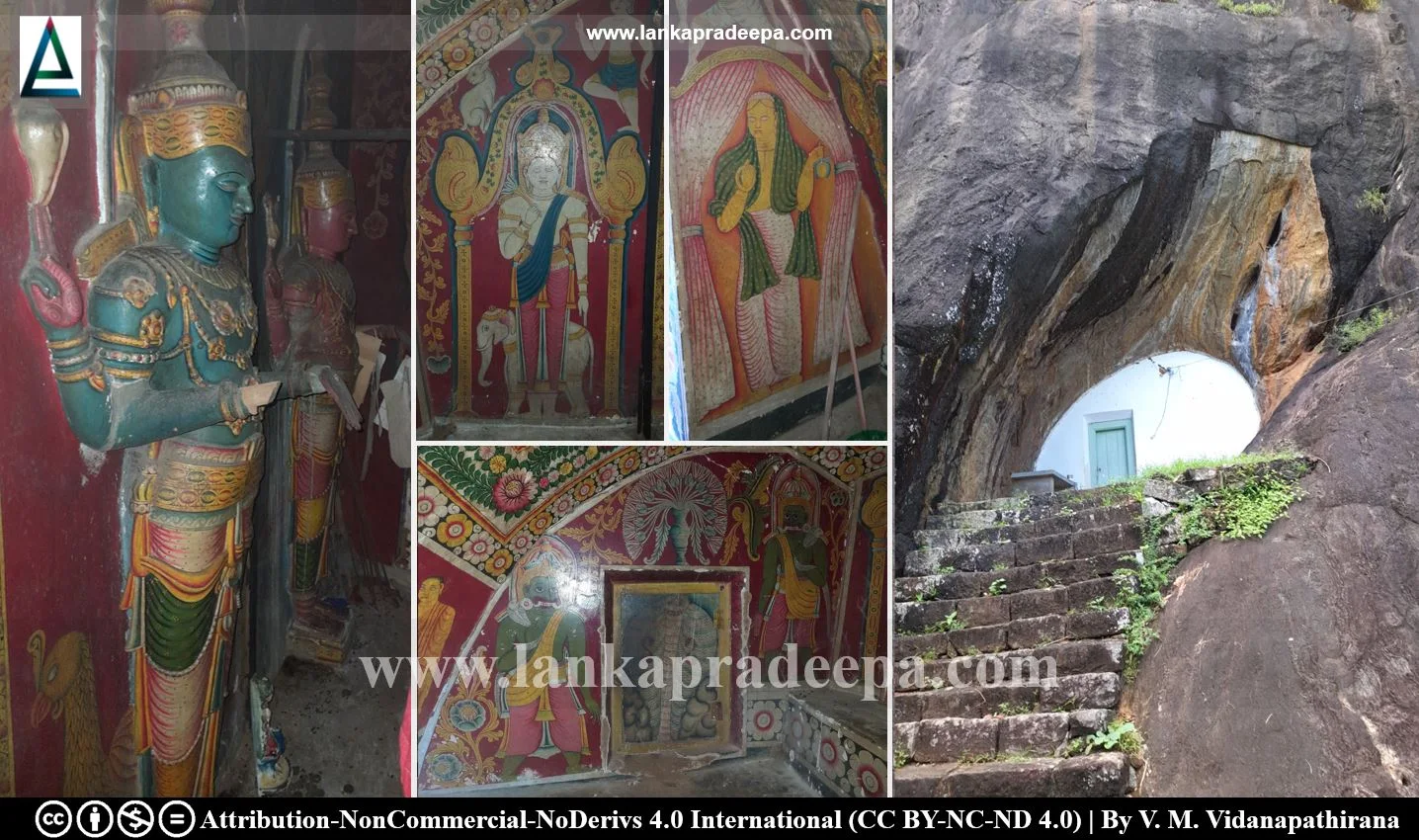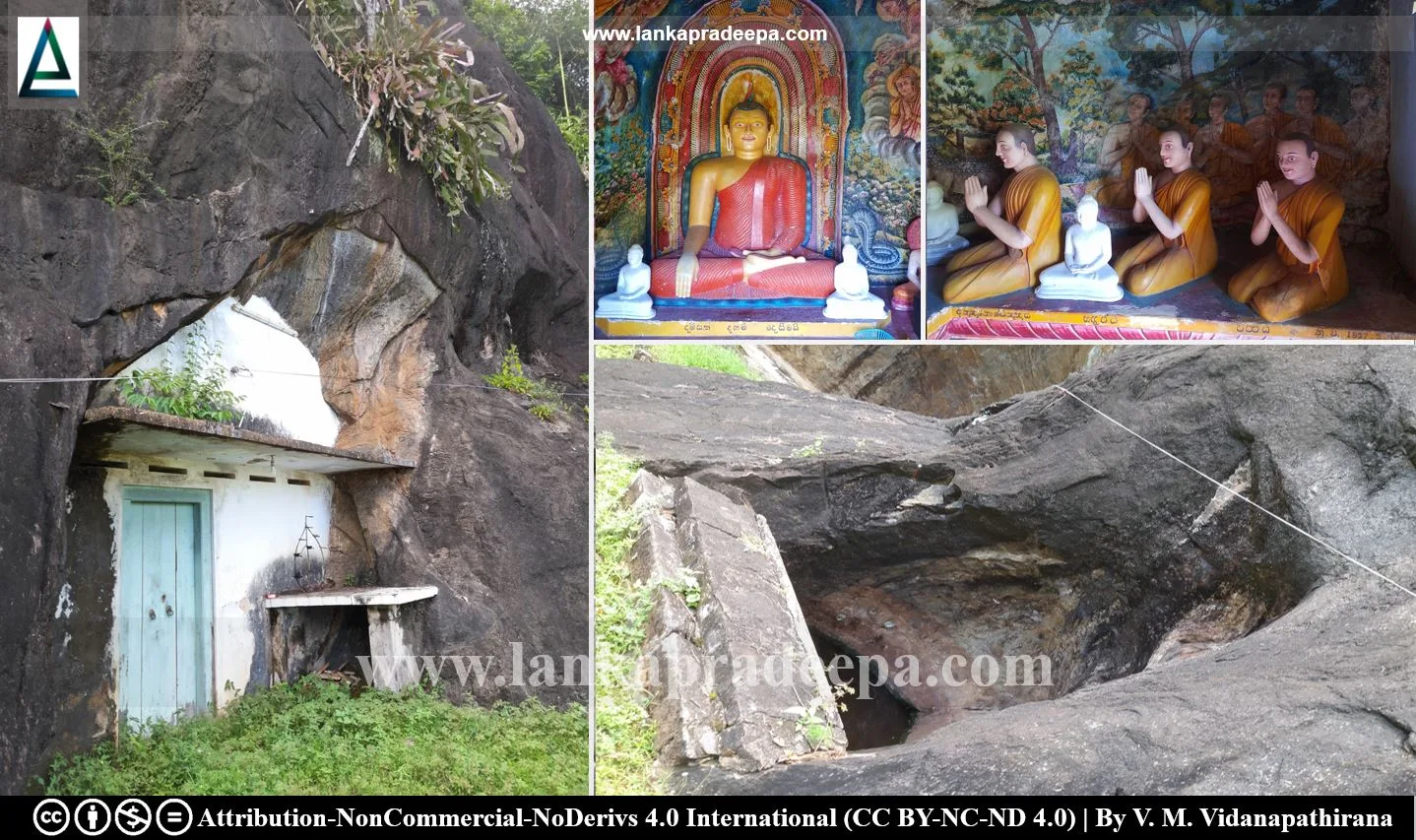
|
The cave temples at Umangala Viharaya |
Umangala Ovagiri Raja Maha Viharaya, also known as Amangala Raja Maha Viharaya (Sinhala: උමංගල ඔවාගිරි රජමහා විහාරය), is a Buddhist cave temple situated in Gangodagama village near Hakmana town in Matara District, Sri Lanka.
Folklore
Built on one of the highest peaks in the area, the temple has got its name Umangala due to a belief that says about a tunnel (Umanga in Sinhala) that runs between this temple and the famous Mulkirigala Raja Maha Viharaya (Abeyawardana, 2004; Ranaweera, 2015). It is said that a king cobra who started from Mulkirigala arrived at Umangala by creating a tunnel. Presently, two cave entrances closed with the painting of a cobra are found at both temple premises (Abeyawardana, 2004).
History

The history of this site runs back to the early part of the Anuradhapura Period. The size of the bricks used to construct the Stupa at the top of the mountain indicates that it could be a work between the 2nd and 5th century A.D. (Abeyawardana, 2004). It is believed that this Stupa was created by King Jetthatissa (263-273 A.D.) of Anuradhapura by the name Elugal Seya (Abeyawardana, 2004; Ranaweera, 2015; Wikramaratne, 2015). The summit on which this Stupa is located can be reached by climbing 424 steps (Ranaweera, 2015).
There are several ponds and three drip-ledged cave temples on the temple premises. The drip ledges are thought to have been chiselled during the same period as the Stupa at the summit (Abeyawardana, 2004). Of the three cave temples, the oldest one contains paintings and sculptures belonging to the Kandyan Period (Abeyawardana, 2004). The other two caves consist of paintings modified in the recent past (Abeyawardana, 2004). One of these two caves has been converted into a Devalaya and it is from this cave that the tunnel is said to start (Abeyawardana, 2004; Wikramaratne, 2015).
Ovagiri Viharaya is mentioned in the chronicle Rajavaliya as well as in the Nampota, an ancient Sinhalese text which is considered to have been compiled after the 14th century A.D. (Wikramaratne, 2015). A Buddha statue at this place is trivially mentioned in a record by Albrecht Herport, a Swiss who served as a soldier in the Hakmana post, Sri Lanka during the period 1663-1665 (Ranaweera, 2015; Wikramaratne, 2015).
The modern temple at the foot of the mountain was built more than 100 years ago (Abeyawardana, 2004).
A Protected Site
The stone well, the ancient Dagoba and the two inscriptions within the precincts of Hakmana Umangala Rajamaha Vihara situated within the Grama Niladhari Division of Gangodagama in the Hakmana Divisional Secretary Division are archaeological protected monuments, declared by the government Gazette notifications published on 6 June 2008.




Related Posts
Read Also
References
Books, Government Gazette Notifications
1) Abeyawardana, H.A.P., 2004. Heritage of Ruhuna: Major natural, cultural and historic sites. Colombo: The Central Bank of Sri Lanka. ISBN: 955-575-073-4. pp.79-80.
2) Ranaweera, D. D., 2015. Matara Urumaya (in Sinhala). ISBN: 978-955-30-6285-7. S. Godage & Bros. pp.38-40.
3) The Gazette of the Democratic Socialist Republic of Sri Lanka. No: 1553. 6 June 2008. p.524.
4) Wikramaratne, I., 2015. Pauranika Sthana Saha Smaraka: Matara Distrikkaya (In Sinhala). Department of Archaeology (Sri Lanka). ISBN: 955-9159-54-2. pp.23-24.
Location Map
Dynamic Google Map
Attribution
To Whom
LankaPradeepa.com extends its gratitude to Mr V. M. Vidanapathirana for providing the necessary photographs required for this article. All the photos are published here with the permission of the author.

